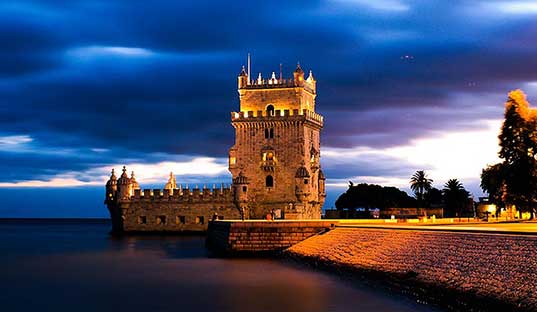History of Lisbon
The history of Lisbon has a very strong connection to the Tagus River, the largest in the Iberian Peninsula. Due to the proximity to the river, the first human beings, the Neanderthal-Homo sapiens, who mainly came from North Africa and other parts of Europe, settled in this region. The existence of human life in that area thousands and thousands of years ago is proven by archaeological discoveries in Lisbon, indicating that the Neanderthals arrived in the Iberian Peninsula about 35,000 years ago. Lisbon is thus one of the oldest cities in the world and in Western Europe, even older than important cities like London, Paris or Rome.
According to the legend, Lisbon was founded by the Greek hero Ulysses, and its first inhabitants were people from the West. The first invasion in Lisbon happened long before the birth of Christ, when several tribes invaded the Iberian Peninsula and settled in the fertile lands on the banks of the Tagus River, where they had the best living conditions.
Archaeological finds, discovered in Castelo de São Jorge (Saint George Castle) and in Sé de Lisboa (Lisbon Cathedral), also prove the presence of the Phoenicians in this city around 1200 BC. We cannot forget that since, at that time, there were no airplanes, cars and post to export or import goods, everything was centred around the sea and the Tagus River, an important route to exchange food and other goods between tribes. Again, due to the geographical location, next to the sea and the Tagus River, the Celts are also believed to have been in Lisbon, that became a major commercial port very early on!
In Roman times, Lisbon was called Olissipo and was one of the most important cities of the Roman Lusitania (the name given to the lands located West of the Iberian Peninsula inhabited by the Lusitanian people since the 'Age of Polished Stone', the Neolithic period), after the alliance with this people. At this time, Olissipo was an important trading point, with several connections to other regions.
After a long looting period, in the seventh century, Lisbon was just a village. Taking advantage of the wars between the Visigoth people, the Arabs attacked the Iberian Peninsula and occupied Lisbon. In Arabic, Lisbon was known as 'Al-Ushbuna', which meant 'charming port'. With this people, Lisbon continued to be a major trading point along the Tagus River, with the exchange of goods to other Arab countries, such as Morocco, Tunisia or Egypt. The city grew to the point that, in the tenth century, it had over 100,000 inhabitants and was one of the largest cities in Europe, surpassing, at that time, Paris or London!
Given the Arab influence, Lisbon, or Al-Ushbuna, was progressively designed and built in the manner of this people, with the construction of a castle (Castelo de São Jorge) and a mosque, besides other influences. This is also the time when Alfama district and the city of Almada (al-Madan) were created.
Arabs gradually introduced their habits, using the Tagus River water to irrigate cultivated fields.
In the year 796, the city is attacked by the Christians and, in 844, by the Vikings. However, Al-Ushbuna is able to withstand various successive attacks for several years.
While in the South the greatest influence was Arabic, in the North the movements to create and expand the County of Portugal had begun, with the first king of Portugal, D. Afonso Henriques, leading the battles. He repeatedly tried to conquer Lisbon, but only succeeded in 1147. That same year, this king took possession of the city and ordered the great mosque that existed there to be converted into the Cathedral. 1195 was the year the city's patron saint, San Antonio, whose real name was Fernando de Bulhões, was born in Lisbon.
With these changes, D. Afonso Henriques tries to recover the commercial importance that Lisbon had and is actually successful. Lisbon is once again an important trading port not only between the North Sea and the Mediterranean, but also North Africa, trading gold, ivory, sugar, almonds, olive oil, salt, wine, cork or rice. Shipyards start to emerge, where boats were built to protect trade from pirates. Boats evolve from barques to caravels, the means used to cross the seas and discover new land.
In the thirteenth century, and by the hand of D. Afonso III, also after having conquered the Algarve, this king chooses Lisbon as capital of the kingdom, since it was the largest and strongest city. The first king from Lisbon was D. Dinis, who created the University of Coimbra, in 1290, which actually first operated in Lisbon and then, in 1308, was transferred to Coimbra. Lisbon is gaining a new face, new streets are created, and Rossio becomes the centre of the city.
Due to this city's growing importance in international trade, merchants from various parts of Europe, such as Jews, Italians, Dutch and English, choose to live in Lisbon, bringing with them navigation skills and knowledge of luxury goods coming from Asia, as spices and silks.
The alliance with the English, the main trading partner of the cities of Lisbon and Porto, dates back to 1308. Due to the tensions with Castile, the city is surrounded but, in 1373, the Castilians are paid to leave the territory. After what happened, the great Muralhas Fernandinas de Lisboa (Ferdinand walls) are built, in the reign of king Ferdinand I of Portugal, to protect the city.
Due to the organisation of society, streets in Lisbon are named after several professions, such as Rua do Ouro (goldsmith), Rua dos Sapateiros (shoemaker), Rua da Prata (because of jewellers who worked with silver) or Rua dos Retroseiros (haberdasher). It is important to bear in mind that, at this time, the most important social class was the bourgeoisie, since they worked in trade, particularly international. From the city's development arise bankers, scientists and even men connected to the law. At this point, Companhia das Naus (Company of the Carracks) also appears, a kind of insurance company to which the shipowners had to pay an amount in exchange for support in the event of losses.
Minorities were dominated by Jews and Muslims (Moors and Arabs). Mouraria, one of the typical districts of the city, has this name because Muslims lived there, most of them uneducated and with low wages, living from agriculture. For example, the expression 'alfacinha', used to call the people of Lisbon, came from the fact that the Arabs cultivate lettuce.
Lisbon's prosperity was shaken several times, with strong earthquakes that destroyed many buildings. However, the city always rose again.
Lisbon was growing commercially year after year, increasingly becoming a connecting city to other countries. Several trade and cooperation treaties were signed with different cities, such as Venice, Genoa or Florence, in the fourteenth century. In the fifteenth century, more specifically in 1415, Ceuta, in northern Africa, is conquered, allowing Lisbon to have a better control of trade in the Mediterranean and to dominate the trading of gold and ivory.
In the fifteenth century, the Age of Discovery, the Portuguese strategy, in terms of trade, changed due to competition. The goal was now to negotiate directly with the source of goods, such as gold, ivory and spices, and this was achieved thanks to Henry the Navigator, who led the Portuguese navy to the countries that produced the most commercially important goods.
With these expeditions, Madeira and the Azores islands are discovered, and the Portuguese reach the Gulf of Guinea. Due to these discoveries, wine and sugarcane begin to enter the trade circuits, but the goal was to go even further. With the support of the Lisbon merchants, Vasco da Gama leads the voyage of the sea route to India, arriving there in 1498. Then, they reach China, Macau, Indonesia and Japan, and on the way back, they prepare business with Angola and Mozambique.
After taking these steps, Lisbon begins to trade new and exclusive products, such as spices, cotton fabrics, diamonds, porcelain or sugar from Brazil, becoming a luxury market in Europe. Controlling the trade from Japan to Ceuta, in the sixteenth century, Lisbon was the richest city in the world!
After a difficult period of struggle and in which other empires seek to destroy the Portuguese monopoly, Lisbon regains its strength when it begins to explore the assets from the colonies, such as the gold from Brazil. However, all this is destroyed by the great Lisbon earthquake, in 1755.
The history of monuments and churches often refers that they were rebuilt or recovered after the 1755 earthquake, which was the darkest moment in the history of Lisbon.
On the morning of the 1st of November 1755 the first tremor was felt and a few minutes later there was a second, far more violent shock, reducing over half the city to rubble. The quake triggered a tsunami, which arrived soon afterwards. As usual the first indication was that the water drew back from the land. Soon, however, the water came back with a wave estimated at 50 feet high crashing through the city. Ships, docks and buildings in the city were battered by the high seas. Thousands of people were swept away.
As if that wasn't enough, lamps and cooking fires upset in the tumult ignited a fire storm that proved impossible to control. It burned unchecked for three days, completing the destruction. In all more than 60,000 people died in the disaster in Lisbon alone. Thousands more died in other areas. The quake was felt throughout Western Europe and Northwestern Africa.
But the reconstruction of Lisbon took place rapidly and no sooner had the tremors abated than the Marquis of Pombal (the Portuguese prime minister of King D. José I) was outlining ideas for rebuilding the city. He started by saying "Bury the dead and feed the living" and then he rolled up his sleeves and began work. Due to his determination and practicality, Lisbon was soon back on its feet and better than ever. The area located between downtown Lisbon and the Marquês de Pombal Square, specially from Rossio Square to Commerce Square, shows the innovative grid system devised by Sebastião José de Carvalho e Melo - the Marquis himself!
Lisbon also underwent a period of liberal wars, synonymous with instability at various levels. In the nineteenth century, Lisbon's trade relations are essentially based on what is produced in the colonies. At a cultural and commercial level, this is a time of changes, and the city centre is now in Chiado. This is also the period of great writers, such as Almeida Garrett, Alexandre Herculano or Guerra Junqueiro, and also when bullfights, fado and revue appear.
Also in this century, the country is industrialised, with a higher concentration of these production units in Lisbon and the prevalence of textiles, tobacco, canned food or rubber. In a period marked by many inequalities, 1910 is the year of a popular uprising in Lisbon. The First Republic is established, and with it came better support measures for the people.
Still, this period was not entirely peaceful, due to successive strikes in Lisbon. During so much political dispute, with the capital as the main stage of these operations, the First Republic falls and a dictatorship rises to power by the hands of António de Oliveira Salazar. Due to the economic and industrial development, the capital undergoes a period of great demographic increase. Shanty towns proliferate on the outskirts of the city, housing the huge number of people who want to live in Lisbon. However, the regime of Salazar and Marcelo Caetano was overthrown by the Carnation Revolution, in the heart of Lisbon, on 25 April 1974. Portugal enters the EU in 1986, and Lisbon has urban plans to rehouse, in a decent manner, the vast population living in problematic areas. Today, the historic city of Lisbon has a clean look and a perfect and unique light. Expo 98 gave Lisbon a major boost and opened an area that today is vital in the city, Parque das Nações (Park of Nations).














